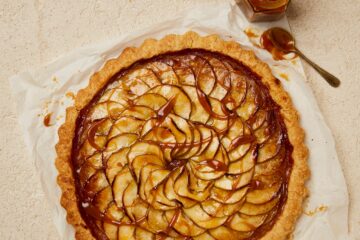Source: Peanut butter chocolate cake and vegan gingerbread: five new sweet recipes from Nigella Lawson
Peanut Butter Chocolate Cake
Servings 12 people
Ingredients
- 200 g unsalted butter
- 250 ml coffee
- 50 g cocoa powder
- 100 g soft dark brown sugar
- 125 g caster sugar
- 2 tbsp vanilla extract
- 225 g plain flour
- 1 tbsp baking powder
- 0.5 tsp bicarbonate of soda
- 2 eggs large, at room temperature
Icing
- 300 g icing sugar
- 150 g unsalted butter soft
- 200 g smooth peanut butter
- 1 tsp vanilla extract
- 0.5 tsp salt
- 60 ml double cream
Instructions
- Heat the oven to 180C (160C fan)/360F/gas mark 4. Butter two 20cm sandwich tins (or four tier-cake tins) and line them with baking parchment. Don’t use loose-bottomed tins as this is a runny batter.
- Cut the butter into four pieces and put into a heavy-based, fairly wide saucepan – I use one of 22cm diameter – and set over gentle heat. Add the coffee, and whisk in the cocoa and both sugars. Keep on a low heat, whisking gently, until the butter has melted, and you have a smooth, amalgamated mixture. Remove from the heat, and stir in the vanilla extract. Let stand for five minutes.
- Measure out the flour in a bowl, add the baking powder and bicarbonate of soda, and mix.
- Whisk the eggs together in a small jug. Pour the eggs gradually into the pan, whisking all the while, until they are completely absorbed.
- Finally, whisk in the flour slowly until you have a smooth batter, and scrape evenly into your waiting tins.
- Bake in the oven for 18-20 minutes (or about seven minutes for the shallow tins), by which time the cakes will be beginning to shrink away at the edges, and a cake tester will come out cleanish. (It’s fine if a few crumbs cling to the tester.) Leave the cakes in their tins on a rack to cool completely.
- To make the buttercream, first sift the icing sugar into a bowl.
- In a large bowl, beat the butter and peanut butter together thoroughly; for three minutes if you’re using a mixer, or five minutes with a handheld electric whisk, by which time you should have a light, fluffy, creamy mixture. Beat in the vanilla extract and salt.
- Still beating, but now at a slightly lower speed, patiently add the sifted icing sugar a spoonful at a time until you’ve used half of it, then beat in the rest in three batches. Once it’s all in, turn up the mixer a little and carry on beating for two minutes, or for three with a handheld electric whisk. Scrape down the sides, to incorporate any sugar clinging to the bowl, and beat again for 30 seconds to one minute.
- Still beating, add the cream a tablespoonful at a time and, when it’s all in, carry on beating for four minutes (or for six minutes with a handheld electric whisk).
- Peel away the lining papers from the cakes, and place one of the layers, flat side up, on a cake stand or plate. If this is a two-layer cake, (armed, ideally, with a bendy spatula and a small offset spatula) spread about a third of the icing evenly on to the waiting cake layer, taking it out to the very edges; this will bulge when you place the other cake on top, which will make it easier to ice the sides.
- Top with your second cake, placing it domed side up, so that the two flat sides are meeting. Then spread another third of the icing over the top. If making a four-layer cake, create your tower, spreading 1cm thickness of icing between each layer, and on the top.
- Use the bendy spatula to get a dollop of buttercream on to the side of the cake, then spread it gently to cover, and smooth, ideally with an offset spatula. Carry on until the cake is covered. Then run the offset spatula round the cake again to smooth the buttercream.




0 Comments